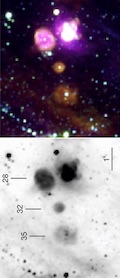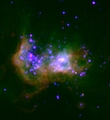



The Superbubble Size Distribution in the Interstellar Medium of Galaxies
M.S. Oey & C.J. ClarkeWe use the standard, adiabatic shell evolution to predict the differential size distribution N(R) for populations of OB superbubbles in a uniform ISM. Assuming that shell growth stalls upon pressure equilibrium with the ambient ISM, and that all shells have the same lifetime t_e, we derive N(R) for simple cases of superbubble creation rate and mechanical luminosity function (MLF). For constant creation and an MLF \phi(L) \propto L^{-\beta}, we find that N(R) \propto R^{1-2\beta} for R < R_e, and N(R) \propto R^{4-5\beta} for R > R_e, where the characteristic radius R_e ~ 1300 pc is the stall radius associated with t_e. For R < R_e, N(R) is dominated by stalled objects, while for R > R_e it is dominated by growing objects. The relation N(R) \propto R^{1-2\beta} appears to be quite robust, and also results from the momentum-conserving shell evolution. We predict a peak in N(R) corresponding to individual SNRs, and suggest that the contribution of Type Ia SNRs should be apparent in the observed form of N(R). We present expressions for the porosity parameters, Q_{2D} and Q_{3D}, derived from our analysis. Q_{2D} is dominated by the largest superbubbles for \beta < 2 and individual SNRs for \beta > 2, whereas Q_{3D} is normally dominated by the few largest shells. We examine evolutionary effects on the HII region luminosity function (HII LF), in order to estimate \beta. If the nebular luminosity {\Lha} fades too quickly, the observed slope a of the HII LF will be steepened, since bright objects are quickly diminished. We find that for a nebular fading {\Lha} \propto t^{-\eta}, there is a minimum observed slope a_{min} for the HII LFs, describing the relative importance of this effect. Empirical measurements all show a > a_{min}, therefore implying that usually we may take \beta = a. We also find that if nebular luminosity is instantaneously extinguished at some given age, rather than continuously fading, no a_{min} will be observed. Comparison with the largely complete HI hole catalog for the SMC shows surprising agreement in the predicted and observed slope of N(R). This suggests that no other fundamental process is needed to explain the size distribution of shells in the SMC. Further comparison with largely incomplete HI data for M31, M33, and Holmberg II also shows agreement in the slopes, but perhaps hinting at systematic differences between spiral and Im galaxies. We estimate porosities that are substantially < 1 for all of the galaxies except Holmberg II, for which we obtain values >~ 1. Most of these galaxies therefore may not be strongly dominated by a hot interstellar component. However, porosity results for the Galaxy remain inconclusive with the available data. 1997 MNRAS, 289, 570
(Uncompress with 'gunzip' if necessary) |

